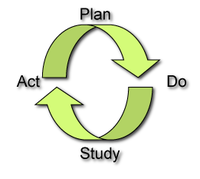Planning a session
| Learning and Teaching in Practice | |
|---|---|
| Module 4: Planning, delivering and critiquing a teaching session | |
| Planning a session | Introduction | Design active, experiential and deep learning strategies | Develop elements of a session | Summary |
This section covers the nuts and bolts of developing a teaching plan for facilitation. This corresponds to the Plan phase of the PDSA cycle. Find out how to distinguish between learning objectives and learning outcomes. Learn how to organise content and resources, and integrate formative assessment as well as evaluate the session.
Why is planning important?
- A well structured lesson increases students' motivation and interest.
- Planning your lesson ensures the content will be in tune with the required learning of the course.
- Planning also helps to filter your content and prompts you to discard what isn't relevant.
In any good design, a planning process must first be followed. Ako Aotearoa has developed a useful guide to the process.
The planning process
Click on the expand button ![]() to the right of each stage of the process for more information:
to the right of each stage of the process for more information:
| 1. Establish the learning objectives |
|---|
| Learning objectives are what you want your students to learn (that is, to know or be able to do) as a result of the session.
Here are some sample learning objectives from another course on WikiEducator.
(Source: Applying Effective Communication Skills) How are learning objectives different from learning outcomes?
Please note: sometimes these terms are used interchangeably or differently from our definitions here! Learning outcomes and objectives are usually written in a standardised format: for more information on how to write learning outcomes and objectives, see Writing Learning Outcomes and Learning outcomes and learning objectives. |
| 2. Decide on the content | |
|---|---|
| Ensure the content will enable the learning outcomes to be achieved.
Also, make sure that the content for the lesson fits with what you taught yesterday and what you will teach tomorrow.
|
| 3. Decide how you will deliver the content | |
|---|---|
| Ensure the content is learner focused and that there are a range of learning activities that will suit your students and their learning styles.
|
| 4. Decide on the order in which you will teach the content |
|---|
Make sure you include an interesting introduction, a logical and well-sequenced main body which includes the key messages, and some way of summarising or drawing the lesson to a conclusion. (Students remember what they heard first and last!)
|
| 5. Decide on resources | |
|---|---|
| Decide what learning resources you need to prepare for your session, both to support your teaching and to give to your students to support their learning.
|
| 6. Think about timing |
|---|
| Break your lesson into manageable learning chunks and estimate how much time to allocate to each.
|
| 7. Formative assessment | |
|---|---|
| Decide how you will know that your students have achieved your objectives for the session - that is, they have understood or learned what you intended.
What activities or questions can you ask your students or get them to complete which will enable you to identify that they have understood the content of the lesson?
|
| 8. Review |
|---|
| What will you get your students to do before the next lesson? What resources can you provide for those students who need additional support? What extension activities can you prepare for those students who want to deepen their learning? |
Acknowledgement: sections of this topic have been based on Ako Aotearoa's Signposts publication (CC-BY-SA).
|
|

